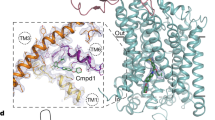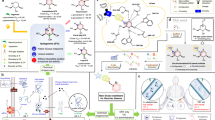Abstract
The Ginkgo biloba metabolite bilobalide is widely ingested by humans but its effect on the mammalian central nervous system is not fully understood1,2,3,4. Antagonism of γ-aminobutyric acid A receptors (GABAARs) by bilobalide has been linked to the rescue of cognitive deficits in mouse models of Down syndrome5. A lack of convulsant activity coupled with neuroprotective effects have led some to postulate an alternative, unidentified target4; however, steric congestion and the instability of bilobalide1,2,6 have prevented pull-down of biological targets other than the GABAΑRs. A concise and flexible synthesis of bilobalide would facilitate the development of probes for the identification of potential new targets, analogues with differential selectivity between insect and human GABAΑRs, and stabilized analogues with an enhanced serum half-life7. Here we exploit the unusual reactivity of bilobalide to enable a late-stage deep oxidation that symmetrizes the molecular core and enables oxidation states to be embedded in the starting materials. The same overall strategy may be applicable to G. biloba congeners, including the ginkgolides—some of which are glycine-receptor-selective antagonists8. A chemical synthesis of bilobalide should facilitate the investigation of its biological effects and its therapeutic potential.
This is a preview of subscription content, access via your institution
Access options
Access Nature and 54 other Nature Portfolio journals
Get Nature+, our best-value online-access subscription
$29.99 / 30 days
cancel any time
Subscribe to this journal
Receive 51 print issues and online access
$199.00 per year
only $3.90 per issue
Buy this article
- Purchase on Springer Link
- Instant access to full article PDF
Prices may be subject to local taxes which are calculated during checkout



Similar content being viewed by others
Data availability
All data is available in the text of this Article or its Supplementary Information. Structural parameters are available from the Cambridge Crystallographic Data Centre (CCDC) under the following reference numbers: (−)-5, CCDC 1911131; (−)-8, CCDC 1911128; 12, CCDC 1911129; and 16c, CCDC 1911127.
References
DeKosky, S. T. et al. Ginkgo biloba for prevention of dementia: a randomized controlled trial. J. Am. Med. Assoc. 300, 2253–2262 (2008).
Wada, K. et al. Studies on the constitution of edible medicinal plants. Isolation and identification of 4-O-methyl-pyridoxine toxic principle from the seed of Ginkgo biloba. Chem. Pharm. Bull. 36, 1779–1782 (1988).
Clarke, T. C., Black, L. I., Stussman, B. J., Barnes, P. M. & Nahin, R. L. Trends in the Use of Complementary Health Approaches Among Adults: United States, 2002–2012.National Health Statistics Reports, no. 79 (US Department of Health and Human Services, 2015).
Kiewert, C. et al. Role of GABAergic antagonism in the neuroprotective effects of bilobalide. Brain Res. 1128, 70–78 (2007).
Fernandez, F. et al. Pharmacotherapy for cognitive impairment in a mouse model of Down syndrome. Nat. Neurosci. 10, 411–413 (2007).
van Beek, T. A. & Taylor, L. T. Sample preparation of standardized extracts of Ginkgo biloba by supercritical fluid extraction. Phytochem. Anal. 7, 185–191 (1996).
Lynch, J. W. & Chen, X. Subunit-specific potentiation of recombinant glycine receptors by NV-31, a bilobalide-derived compound. Neurosci. Lett. 435, 147–151 (2008).
Ivic, L. et al. Terpene trilactones from Ginkgo biloba are antagonists of cortical glycine and GABAA receptors. J. Biol. Chem. 278, 49279–49285 (2003).
Huang, S. H. et al. Bilobalide, a sesquiterpene trilactone from Ginkgo biloba, is an antagonist at recombinant α1β2γ2L. Eur. J. Pharm. 464, 1–8 (2003).
Thompson, A. J., McGonigle, I., Duke, R., Johnston, G. A. R. & Lummis, S. C. R. A single amino acid determines the toxicity of Ginkgo biloba extracts. FASEB J. 26, 1884–1891 (2012).
Nakanishi, K. et al. Structure of bilobalide, a rare tert-butyl containing sesquiterpenoid related to the C20-ginkgolides. J. Am. Chem. Soc. 93, 3544–3546 (1971).
Strømgaard, K. & Nakanishi, K. Chemistry and biology of terpene trilactones from Ginkgo biloba. Angew. Chem. Int. Ed. 43, 1640–1658 (2004).
Vale, S. Subarachnoid haemorrhage associated with Ginkgo biloba. Lancet 352, 36 (1998).
Ng, C. C., Duke, R. K., Hinton, T. & Johnston, G. A. R. Effects of bilobalide, ginkgolide B and picrotoxinin on GABAA receptor modulation by structurally diverse positive modulators. Eur. J. Pharm. 806, 83–90 (2017).
Weinges, K., Hepp, M., Huber-Patz, U., Rodewald, H. & Irngartinger, H. Chemistry of ginkgolides. 1. 10-acetyl-1-methoxycarbonyl-2,3,14,15,16-pentanorginkgolide-A, an intermediate for the synthesis of bilobalide. Liebigs Ann. Chem. 1057–1066 (1986).
Harrison, T., Myers, P. L. & Pattenden, G. Radical cyclisations onto 2(5H)-furanone and maleate electrophore. An approach to the spiro- and linear-fused γ-lactone ring systems found in the ginkgolides. Tetrahedron 45, 5247–5262 (1989).
Emsermann, J. & Opatz, T. Photochemical approaches to the bilobalide core. Eur. J. Org. Chem. 3362–3372 (2017).
Corey, E. J. & Su, W. G. Total synthesis of a C15 ginkgolide, (±)-bilobalide. J. Am. Chem. Soc. 109, 7534–7536 (1987).
Corey, E. J. & Su, W. G. Enantioselective total synthesis of Bilobalide, a C15 ginkgolide. Tetrahedr. Lett. 29, 3423–3426 (1988).
Crimmins, M. T., Jung, D. K. & Gray, J. L. Synthetic studies on the ginkgolides: total synthesis of (±)-bilobalide. J. Am. Chem. Soc. 115, 3146–3155 (1993).
Fernández-Ibáñez, M. Á., Maciá, B., Alonso, D. A. & Pastor, I. M. Recent advances in the catalytic enantioselective Reformatsky reaction. Eur. J. Org. Chem. 7028–7034 (2013).
Wolf, C. & Moskowitz, M. Bisoxazolidine-catalyzed enantioselective Reformatsky reaction. J. Org. Chem. 76, 6372–6376 (2011).
Crossley, S. W. M., Obradors, C., Martinez, R. M. & Shenvi, R. A. Mn-. Fe-, and Co-catalyzed radical hydrofunctionalizations of olefins. Chem. Rev. 116, 8912–9000 (2016).
Obradors, C., Martinez, R. M. & Shenvi, R. A. Ph. (i-PrO)SiH2: a remarkable reductant for metal-catalyzed hydrogen atom transfers. J. Am. Chem. Soc. 138, 4962–4971 (2016).
Maier, G., Pfriem, S., Schäfer, U. & Matusch, R. Tetra-tert-butyltetrahedrane. Angew. Chem. Int. Edn Engl. 17, 520–521 (1978).
Fernández|González, D. F., Brand, J. P. & Waser, J. Ethynyl-1,2-benziodoxol-3(1H)-one (EBX): an exceptional reagent for the ethynylation of keto, cyano, and nitro esters. Chem. Eur. J. 16, 9457–9461 (2010).
Keck, G. E. & Wagner, C. A. The first directed reduction of β-alkoxy ketones to anti-1,3-diol monoethers: identification of spectator and director alkoxy group. Org. Lett. 2, 2307–2309 (2000).
Julia, M., Saint-Jalmes, V. P. & Verpeaux, J. N. Oxidation of carbanions with lithium tert-butyl peroxide. Synlett 1993, 233–234 (1993).
Weinges, K., Hepp, M., Huber-Patz, U. & Irngartinger, H. Chemistry of ginkgolides. III. Bilobalide/isobilobalide. Structure determination by X-ray analysis. Liebigs Ann. Chem. 1079–1085 (1986).
Byun, K., Mo, Y. & Gao, J. New insight on the origin of the unusual acidity of Meldrum’s Acid from ab initio and combined QM/MM simulation study. J. Am. Chem. Soc. 123, 3974–3979 (2001).
Acknowledgements
We thank P. Baran and K. Engle for conversations, and the Engle laboratory for donations of chiral phosphoric acids, including (−)-B. A. Rheingold, C. Moore and M. Gembicky are acknowledged for X-ray crystallographic analysis. We thank J. Chen and B. Sanchez in the Scripps Research Automated Synthesis Facility for purification assistance and for analysis of chiral non-racemic compounds. Support was provided by the National Institutes of Health (R35 GM122606) and the Uehara Memorial Foundation; additional support was provided by Eli Lilly, Novartis, Bristol-Myers Squibb, Amgen, Boehringer-Ingelheim, the Sloan Foundation and the Baxter Foundation.
Author information
Authors and Affiliations
Contributions
R.A.S., M.A.B., R.M.D. and M.O. conceived the project. R.A.S. directed the research, and R.A.S., M.O., M.A.B. and R.M.D. composed the manuscript and the Supporting Information section. M.O., M.A.B. and R.M.D. completed a first-generation synthesis of rac-1. M.A.B. conceived and developed the catalytic asymmetric synthesis of (−)-7. M.A.B. observed, designed and optimized the parallel kinetic resolution of rac-9. M.O. and R.M.D. screened and optimized conditions for the alkyne oxidation of rac-12 and (+)-12. R.M.D. developed the hydration of rac-8 and (−)-8 and optimized scale-up campaigns of rac-5 and (−)-5. M.A.B. and R.M.D. conducted large-scale syntheses of rac-5 and (−)-5. M.A.B. and R.M.D. investigated the rearrangement of rac-5 and (−)-5 to 16a–c. M.O. discovered an oxidation of rac-5 to rac-1. M.A.B. investigated the rearrangement of rac-5 and (−)-5 to 16b and 16c, and discovered conditions that were utilized for the oxidation of rac-5 and (−)-5 to rac-1 and (−)-1; M.A.B. and R.M.D. both optimized this process.
Corresponding authors
Ethics declarations
Competing interests
The authors declare no competing interests.
Additional information
Publisher’s note Springer Nature remains neutral with regard to jurisdictional claims in published maps and institutional affiliations.
Supplementary information
Supplementary Information
The Supplementary Information contains detailed procedures, additional supporting figures, as well as the required spectral data for publication
Rights and permissions
About this article
Cite this article
Baker, M.A., Demoret, R.M., Ohtawa, M. et al. Concise asymmetric synthesis of (−)-bilobalide. Nature 575, 643–646 (2019). https://doi.org/10.1038/s41586-019-1690-5
Received:
Accepted:
Published:
Issue Date:
DOI: https://doi.org/10.1038/s41586-019-1690-5
Comments
By submitting a comment you agree to abide by our Terms and Community Guidelines. If you find something abusive or that does not comply with our terms or guidelines please flag it as inappropriate.



